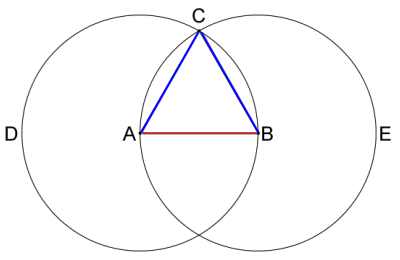Straightedge and compass constructions
This is a quick note about straightedge and compass constructions, in relation to my set.
A quick definition: a straightedge is an arbitrarily long straight edge, and a compass is a circle drawing tool. Specifically, with a straight edge you can:
Pick any two lines and draw the line through them
Pick a point and draw a line through it
Draw an arbitrary line
And with a compass you can:
Pick two points, and draw a circle centered at with radius
Pick a point and draw a circle centered at that point
Draw an arbitrary circle going through a point
Draw an arbitrary circle
Just a quick note about a compass, assume in the questions that you are using a non-collapsing compass, that is, if you draw a circle then you can make your next circle have the same radius as the circle you constructed free of charge.
I'll call a geometric construction constructible if it can be constructed with a straightedge and compass. For example

which shows that an equilateral triangle is constructible.
A constructible number, say , is defined as follows:
If given a unit length, it is possible to construct a segment of length .
Also a shape is constructible given another shape if it is possible to construct another shape given the first one. So although a -gon is not constructible, it is constructible given an -gon.
Lastly a use is a single use of a compass or straightedge, as defined above. So the equilateral triangle takes 5 moves.
Again this is in relation to my set.
Easy Math Editor
This discussion board is a place to discuss our Daily Challenges and the math and science related to those challenges. Explanations are more than just a solution — they should explain the steps and thinking strategies that you used to obtain the solution. Comments should further the discussion of math and science.
When posting on Brilliant:
*italics*or_italics_**bold**or__bold__paragraph 1
paragraph 2
[example link](https://brilliant.org)> This is a quote# I indented these lines # 4 spaces, and now they show # up as a code block. print "hello world"\(...\)or\[...\]to ensure proper formatting.2 \times 32^{34}a_{i-1}\frac{2}{3}\sqrt{2}\sum_{i=1}^3\sin \theta\boxed{123}Comments
There are no comments in this discussion.